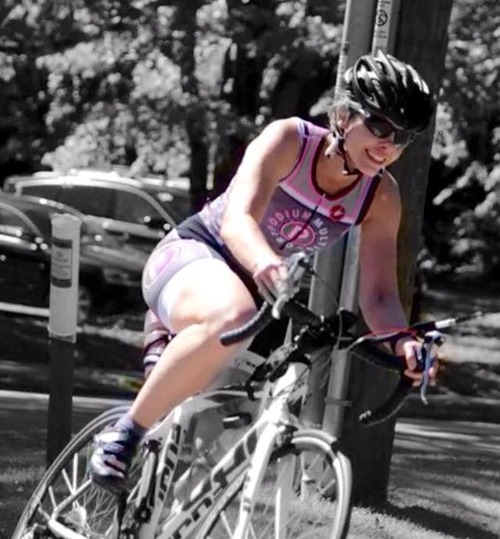By: Angela Gill Nelms
New Years was approaching and all of my friends were doing cool triathlete/running/cycling traditions. Matt from Podium posted that he was going to join a group of cyclists for a New Year’s Day Airport Ride at a “Steady Tempo” pace. (Translation: a bunch of really good cyclists were going to get into a peloton and fly like a swarm of bees for ~70 miles).
Several of us piped in that we would join either for the 70 miles or for a slower and much shorter version of the ride. I figured that based on the terrain I could go about 17-18 mph. In the beginning everyone started at a decent pace and so I held with the group. Matt told me to try to get towards the front and if we hit a hard spot he would push me. “Don’t get squirrelly, just look straight ahead!” he said.
We hit a hill and I was in the middle of the group. I felt my nerves hit me. My cadence dropped and I made the error: I shifted. As soon as I did it felt like I was standing still and the swarm was flying around me. In a matter of seconds I was the dropped girl.
At first I was determined to get back with the group and I pushed myself to catch up. I got really close and then another hill hit and I realized that the energy I needed to catch them wasn’t going to help my long run the next day. My coach had told me I could do the ride but to be smart. Chasing a peloton I would likely never catch was not smart. So, I let go and made the decision to finish alone.
Here are my 5 keys to surviving “the drop”:
- Be Prepared: Have your own copy of the route! Leading up to the ride I knew there was a good possibility that I could end up on my own. I researched the route (many popular cycling routes are posted online on pages such as www.RideWithGps.com) and found one that started close to where we were starting. I programmed it into my Garmin 810. When we started that morning I selected the course and had it running and ready for me in the event I would need it. Make sure that others also know your route and your expected start/finish times.
- Carry Your Phone and RoadID: My Garmin worked great! I was riding away at my happy steady pace when I looked down and I no longer saw the token purple line I was supposed to be following on my Garmin.It never sent me an “off course” alert so for a moment I was perplexed. I soon realized that I had already passed the course starting point and so in its mind I was done. The problem was I wasn’t. I knew I was close to where I wanted to be but I was NOT there and I was not in a good area of Downtown Atlanta. So, I got out my phone and used Google Maps to direct me safely back to my car. Your phone is not only a backup GPS, but also a way for you to call for help or for others to see where you are. My family uses an app called “Life360” and so we can pull up where the other family members are at any time. We can also see their path so that if someone were to suddenly disappear we would know where they were last. I also run the RoadID app which will send an alert to my husband if I stop for too long and don’t respond. This is helpful in the event of a bike accident. I also ALWAYS wear my RoadID. Always.

- Learn Basic Bike Repairs: Do not be that girl who rides with guys solely so that they can change her flat tire. PLEASE learn to change your own tires (front and back), fix your chain, and know when to call for help. Carry an extra $20 with you for emergencies.
- Be Alert and Confident: No headphones, please. Don’t ride so hard that you get “in the zone” and become clueless about your surroundings. Pay attention to cars, pedestrians, animals, and the road. Be careful about what body language you send to those watching you. If you appear to be lost, tired, or scared then it will show and you will look like a potential target. If your intuition peaks about danger listen to it and act accordingly.
- Know and Practice Your Self Defense Method: Learn to protect yourself and be prepared to do so. I highly recommend that everyone take a good self defense course. Many females find false comfort in carrying pepper spray, mace, or even tasers without ever learning to use them properly. These tools can easily be used against you by a perpetrator. Whatever your personal method is the most important thing is to KNOW it and to PRACTICE it.
Angela out on a ride
It is always best practice to ride with groups. However, as you strive to improve your skills you will improve faster by riding with those who are better than you. Don’t let the fear of “the drop” hold you back from being the best you can be!


 SWIM
SWIM
 BIKES
BIKES
 APPAREL
APPAREL
 NUTRITION
NUTRITION
 COMPONENTS
COMPONENTS
 ACCESSORIES
ACCESSORIES
 Podium Multisports Blog
Podium Multisports Blog










